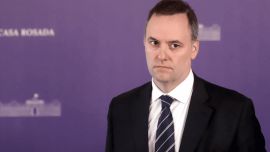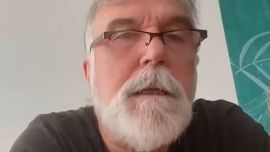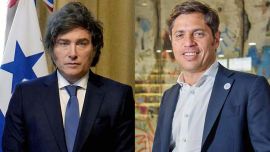Slum priest José María Di Paola, better known as ‘Padre Pepe,’ is the co-founder and current president of the Federación del Hogar de Cristo charity, which was inaugurated by Cardinal Jorge Bergoglio (as Pope Francis was previously known) for assisting the recovery of addicts in shantytowns. Today, the NGO has more than 200 centres nationwide.
In a feature interview, the Burzaco-born priest, 60, discusses poverty, the 10th anniversary of Francis’ papacy, the pontiff’s influence on the faithful and the impact of the Second Vatican Council on the Catholic Church as a whole.
How much does the spirit of the papacy of Francis have to do with the ethos of the Federación del Hogar de Cristo?
When I got to know [Cardinal Jorge] Bergoglio in the villas [shantytowns], I saw the time he dedicated, which impressed me because he had so much to do – indeed, he was greatly sought after in the [Roman] Curia but yet always found the time with much constancy and discipline to go to the shantytowns and the sanctuaries. You could see him in sanctuaries like San Cayetano and San Pantaleón where he went to hear confessions and attend the people passing by as he also went out to the shantytowns. So his outlook on the city as the bishop of Buenos Aires was not downtown, where everything is at its best and where all the power is concentrated, as in Plaza de Mayo, for example. It was an outlook from the fringe from where he spoke – the importance of knowing the totality [of the city] from the fringe. And I believe that has also greatly influenced us to go deepening that path, as well as marking his own stance at the helm of the universal Church, the Church in the world, for example, his trips to Africa, without bothering about the numbers or the repercussions but giving importance to being where he felt he ought to be on the side of the people there. And that is something very important which has also marked out an example for us.
How much of the slum priest tradition founded by [Father Carlos] Mujica 50 years ago has been brought by him to the Vatican?
He greatly empathised with our team – for example, one of the things he valued was the priest living in the neighbourhood as just another neighbour to construct the life of the Church and its spiritual and social work on the spot. So when he speaks of the spiritual community, as he afterwards manifested in his encyclicals, this also has to do with this experience – it has some influence and some connection with that outlook on the life of the Church.
He says that the shepherd must be among his sheep. Can a bishop or cardinal do that?
Yes, take the case of Oscar Ojea, who was my parish priest so I know him well. Even as head of the Synod, he is a person who has contact with the people of his neighbourhood, which really makes it possible with escapes like those of Bergoglio when he was cardinal.
One day, I remember, when he was in Villa 21, he rang me up and told me: “Look, I have an Italian friend who wants to know the shantytown.” He was on holiday from the Curia but the only difference is that he had a [cardinal’s red] skullcap on. When we went walking around the neighbourhood, people said to him: “But aren’t you Monsignor Bergoglio, who confirmed us?” Every December 8 he would come and do confirmations.
He is said to ring up at any hour of the day. Does he still repeat that?
I sometimes email him when I need to ask him something directly on issues where I have to speak. But when he was the bishop of Buenos Aires, we rang him up, knowing there was a time – 6.30pm–7pm – when he attended directly. And that was very important because there were complicated issues and he knew that in the shantytowns things are sometimes black and white, so you very often have to be dependent on the answer.
How is your relationship with Francis nowadays?
With Bergoglio it was truly very good because we were working together. The spirit which he gave the Church really never surprised me because we knew him. But I was happy to see him take a qualitative leap because he is a more joyful person.
He had a grimmer face, as if he were annoyed or worried.
Yes, for example, in the photos of his communion and confirmation services with people, you see him as always serious and I believe in that sense that, as an intelligent man, he was thinking that he had turned 75 and nothing was going to change but it can change if the challenge is greater and when you know that a smile or gesture of yours is communicated to all humanity. The role he has to play seems really positive to me.
Do you remember when John Paul II came?
Yes, I was there both times. In 1982 I was a seminarian and we had to prepare for the visit from one moment to the next. We seminarians did a lot of the preparatory work for the Pope’s arrival. And in 1987 I was ordained a priest. He went to several places and spent Palm Sunday here. For both occasions I did preparatory work.
Why do you think that the Pope does not come and do you think he will at some point?
At some point I think that he was convinced that he was coming and afterwards decided that it was not the time. But I think that at some point we must get him to come to Argentina because the people want him to come. If you ask around in a villa or in a province, the people really want to meet the Pope, to have a really profound spiritual moment, as we had with John Paul II, but this time…
With greater intensity, obviously.
I hope that at some point the circumstances are right and he can say: “I’m going to Argentina.”
A Palo Alto semantics school proposes that you are always communicating, even when not communicating. Evidently by not coming, he is sending us a message. What interpretation do you give?
I think it could be that Argentina needs more unity and less rivalries, that dialogue and consensus are attainable alongside differences and I think that is Argentina’s great challenge at every level. Recently after the World Cup we seemed like a different country for a few days, it even had a contagious effect on some things. I remember that the following Sunday more people went to Mass than usual.
What does it mean that Francis might be said to be the first Pope to be absolutely a product of the Second Vatican Council?
It could be that he has it more incorporated because in the others we really find an effort to keep the Church in touch with the challenges of its times. The Council was really an extraordinary work. I think that Bergoglio has that possibility to feel himself a son of the Council.
In that sense three-quarters of the cardinals with the right to vote were appointed during the papacy of Francis. Is that papacy a turning-point, changing the Church?
I think so. Francis is marking out the most important milestones for the path the Church must tread. Priests, nuns and lay people are being called to reflection in a very big way and many things are also being put in order. He emphatically speaks of an open Church, of an outgoing Church, the Church as a field hospital or, as he tells youth: “Hagan lío (“raise hell”).”
In his Panamá speech he talked of the Federación de los Hogares de Cristo as an example, which we are now going to celebrate. In other words, that outgoing Church which goes out to work instead of shutting itself up in a temple, complying with religious services but extending its life into society with social commitment. But that is also a beginning which he has marked out and which others will follow. There must be somebody who takes up this idea, this project.
Is this a turning-point in the history of the Church, like the Second Vatican Council?
I don’t know, for me it will be more like a continuity which will make it possible for many of the ideas which Francis is promoting today to be translated into concrete works.
To what do you attribute many of the reforms which he is trying to carry out being more resisted within the ecclesiastical hierarchies than in the general population?
I know very little about the Roman Curia but it seems to me that those groups who are accustomed to look inwards at the Church are precisely those who oppose the thinking of Francis so you run into the biassed outlook of this small but really very powerful group. Indeed the reactions we are seeing from some of these groups signify that Francis is putting the Church back into the language of the Gospels with a commitment to an outgoing faith – the contrary of these groups.
Is there something about him which triggers a certain admiration from the people and a certain resentment in those who consider that the Church must not be wordly?
Sure because they consider some things to be wordly which in reality are what Jesus did, for example, approaching lepers, the dissolute, drunks. What Jesus did would also perhaps be wordly for these groups.
Changing the Church from not being wordly is the spirit of the Second Vatican Council. Beforehand a priest celebrated mass while turning his back on the people in a language which they did not understand.
There are groups who always resist changes, more similar to the Pharisees of the Gospels, bound to custom and incapable of seeing the importance of faith or religion.
The Pope stresses the theme of habitat. Is there anything in the habitat of the villas which modifies the subjectivity essential to the perspective any person has on life?
Yes, there are also some healthy things in the villa. For example, the relationships with neighbours in those low-income neighbourhoods, which is a very direct relationship like the traditional neighbourhoods had 50 years ago.
The neighbour was part of your family.
I believe that in the villa, habitat is precisely feeling other people to be your neighbours. Indeed when the pandemic started and they issued this publicity message: “Stay home, take your work home,” we told the president that this message was not the correct one because it would not be possible in those neighbourhoods to shut people up in a sheet metal hut where many lived and he grasped the point. The message was changed to: “Stay home, stay in your neighbourhood.” The villa is a prolongation of home because generally there is room for everybody because if one thing matters in these neighbourhoods, it is that somebody coming from Paraguay with nothing finds a neighbour to give them a place to start their home, at least for a while.
Is there greater solidarity?
There is more solidarity. You have those problems of marginal society occasioned by violence and drugs but on the other hand you find those values which we slum priests have detailed in a paper on urban integration speaking of those villa values coming precisely from a community habitat which makes the lives of other people happier because people are interested in others.
Bergoglio speaks of learning from the poor. What did you learn from them?
Ever since I entered the shantytowns, I’ve been learning every day. One of the things I learned is that the poor should not be solely objects of aid, you can organise things but the poor person has to be the protagonist in that aid. And they’ve taught me that they have many human qualities, they have values and even skills which they have still not been able to develop due to the situation in which they live. But once they do begin to develop them, they form part of the community and, I would say, even take the lead in certain things. For example, a lad who was homeless four years ago in the José León Suárez shantytown today is the operational director of the soup kitchens, giving many people something to eat. In the last few years he has finished secondary school and recovered his children. So they have taught me that they have a very great capacity for resilience while their spirituality is very deep. I have also been taught that the poor person is profoundly religious but not because they need to be because they don’t have anything else but because they really have been brought up in a profound and serious faith. So that opening which they offer, once you get inside, has helped me a lot as a priest, as well as to organise the life of the Church.
What knowledge of faith does a person in that situation of poverty have which goes missing in those who have all their needs satisfied?
They have a greater feeling of transcendence giving a meaning to life and making them value what they have because those who have little value it highly and often have that sense of solidarity to share the little they have with others. As I was telling you, somebody who has a small plot of land still makes room in it for somebody coming from outside. or receives into their homes the children of a woman sick in hospital even when having four or five children themselves, but nevertheless starting to bring up those of their neighbours as well. So there are some really very spiritual dynamics but also with solidarity.
You mention the three Cs – chapel, college, club. What is the factor of these three Cs in structuring lives?
We believe within the reality of Argentina today it is very important for preventive work to strengthen neighbourhoods institutionally.
For a long time there has been a phoney discourse speaking against the institutions when in reality what must be done if an institution goes wrong is to turn it around so that it starts working well. So they have demolished the clubs and closed down chapels while thinking of schools as classrooms and nothing more. We sum this up as the three Cs – chapel, club, college – but there may be other factors within a neighbourhood which, when it has its institutions up and running, permit the child a period of healthy growth during infancy and adolescence. So a chapel with projects and camps and full of life; a club with different sports proposed and inserted in the neighbourhood; and a school which thinks beyond the classroom – they all have to put the worst-off child in first place. Such coordinated work permitted us to live within our neighbourhoods when young with a local club, the parish and a school which all went towards shaping us. That is what low-income neighbourhoods need and I believe that this system of preventive work we have going in the villas is producing many results.
What do you think is the difference between such neighbourhoods in Argentina and in other countries? Is there any point of contact?
I wouldn’t know what to tell you about other countries. Moving around this country on pilgrimages, I found plenty of similarities among many neighbourhoods now registered in the RENABAP (Registro Nacional de Barrios Populares), where many of our centres are based. There are points of contact and also differences. The shantytowns of the Capital grow more upwards while those inland are more extended with no upper storeys. But you might say that there is a similarity within Argentina so that it is possible to work on many of these issues, as we are doing jointly.
It is now 50 years since Father Mujica, who belonged to the movement of Third World priests, began work in the villa in the Cristo Obrero parish. Do you feel Mujica as a kind of pater seraphicus, a guide?
Yes, we assign Mujica a very import place in our spiritual life because he was one of the foundational team also including Fathers Ricciardelli, Vernazza, Goñi and Daniel de la Sierra -–there were several but Mujica is the martyr of that group, inspiring us to accept the challenges which the shantytowns presented at different times.
There was one set of challenges in his time, another following the dictatorship and now another in our times with those neighbourhoods starting to have problems of violence. So we have to meet the challenges with the same spirit and the same intensity in our pastoral work but facing different realities. We really have him as somebody who inspires you rather than living off nostalgia. But what would Mujica do today? Trying to reflect on that, as we often do as a team, we try to find answers to these times in which we live.
Argentina in 1974 had a poverty rate of four percent with six percent unemployment and a per capita income equivalent to that of Australia or Canada, a totally different world. Shantytowns then and now are very different things.
In those times many people were in and out of the villas – they were temporary residents who found jobs and then left. And I believe that today’s villa is also the fruit of the reality of a changed country. It’s the same inland where huge conglomerates have been formed because people left the countryside. Thus you go to cities like Santiago del Estero and [neighbouring] La Banda and they have grown a lot with any amount of new neighbourhoods and changing situations.
What exactly are the Hogares de Cristo?
They began as a territorial proposal because we were not seeing any concrete answers to the problem of addictions in the villas unless they went to therapeutic communities, which were inaccessible with a very distant state (we’re talking about 15 or 20 years ago). So we started moving a kind of proposal born in the community – if a person grows up in the community, then they can also recover within the community. A big effort must be made involving the entire community, as was the case of Villa 21, which accepted this proposal. They might be your children or grandchildren or a neighbour. And so it was designed to be within a given territory.
I was then covering two parishes, Caacupé and Virgen de Luján, in Parque Patricios. We literally cut it in half, transforming it into the first centre. So the kids of Zavaleta or Villa 21 could walk over here or we went looking for them in a car – we have a minibus with which we pick them up to spend the day. We began to design a proposal whereby they were received with great affection so that the kids really don’t feel they’re throwaway. A group is received with great affection and offered conversation and food. If they are homeless and need a bath, they can. We began to offer places for rehab where they might begin a spiritual journey and there the other part of our proposal begins. It is not only a territorial but also an integral approach because a kid from low-income neighbourhoods has many problems, not just coming off drugs. If on a farm for a year, he might quit drugs – the issue is that he might also have health problems and sometimes lacks identification documents or is in trouble with the law.
So how can we go about offering that integral approach? The Hogar de Cristo home has proposed as its objective a territorial and integral approach to addictions. And what started in Villa 21 was replicated in other shantytowns in the capital and afterwards extended nationwide. It is a simple, concrete and practical proposal born in the Church and otherwise taken as a model for addiction policies among so many other models. With the endorsement of the Sedronar [national anti-drug authorities] we could have access to psychological and psychiatric assistance and a call line, enabling us to make the life signified by Hogar de Cristo in a neighbourhood stronger and more dynamic. There was a lot of work within the community and that is the important thing – many of the things we have in low-income neighbourhoods like job training schools and forms of assistance so that these youngsters, once recovered, begin to...
In the youth conference in Panama, the Pope cited the example of what you do. Is it something which can be replicated beyond Argentina?
Yes indeed, we’re chatting to people from other Latin American countries, who are watching our experience and who really have the intention of doing the same thing in some cases. We always say that this practical and concrete way of doing things is not just a question of professionals because there is often the tendency to think that only the professional is going to solve the problem, even among those who have already taken that step and recovered. We call these accompanying partners, thus transforming the youths themselves into the most important protagonists of the recovery of their mates whose references are kids who perhaps three years ago were in the same situation as themselves.
Production: Melody Acosta Rizza and Sol Bacigalupo.






















Comments